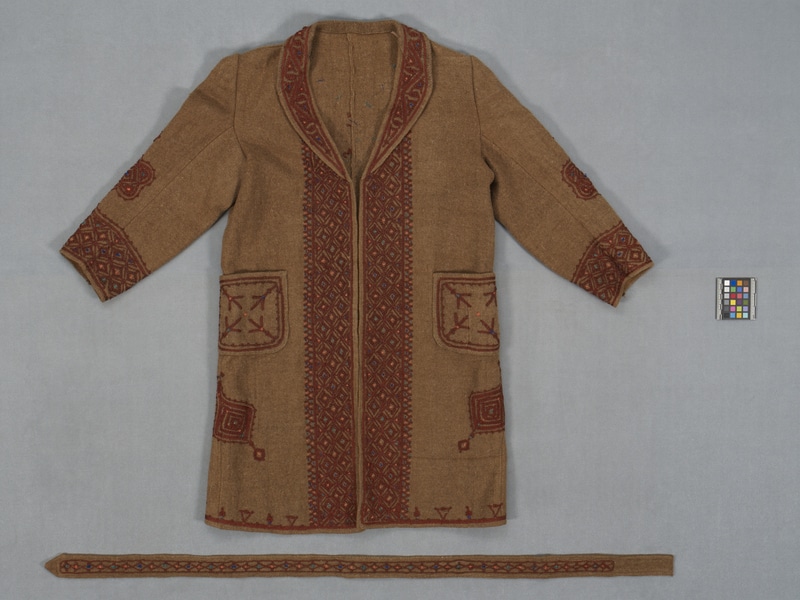Coat Item Number: 2878/16 a-b from the MOA: University of British Columbia



Description
Long sleeved, light brown coat (part a), open at the front with belt (part b) for closure. There is red-brown embroidery on either side of the opening, the lapels, pockets, sleeves, and on the back and at the bottom of the jacket. Throughout the embroidered design there are blue, green and orange circles. The design of the embroidery is a repeating floral and hatch work pattern. The design found on the back side of the coat is the same pattern as that found in the centre, top of the jacket. The pattern on the sleeves and lower front lapels is reminiscent of Kashmiri style of “mango pip” paisley shapes. The belt is also light brown with red-brown embroidery in a repeating diamond pattern. In the centre of each diamond are alternating green, orange and blue circles. One end of the belt tapers to a point while the other end is squared off.
Specific Techniques
This coat was sewn by Chitrali tailors (darzee) in the Chitrali Bazaar and then sent home to be embroidered by women. The method of making the coat is traditional - its created by cutting and attaching woven strips (pati) that were hand-woven from hand-spun natural, undyed wool (pusp). The pati strips are cut from bolts of pati to length and then pieced together, stitched and then the seams and edges are hemmed. The cut appears to have some European influences (Chitral was the most northwestern outpost of the British Raj). The embroidery is classic Chitrali style with aniline-dyed art silk embroidery threads twisted/corded and applied as a chain stitch to create repeating floral-type and hatch work designs. The patterns on the sleeves and lower front panels are reminiscent of the Kashmiri style "mango pip" paisley shapes. being neighbouring regions, both could be drawn from the same original sources.
Cultural Context
woman's coat
Item History
- Made in Chitral, Northwest Frontier, Pakistan
- Owned by Tamarin Productions Inc. before May 4, 2011
- Received from Tamarin Productions Inc. (Seller) and Ruth Read Bequest (Funding source) on May 4, 2011
What
- Name
- Coat
- Identification Number
- 2878/16 a-b
- Type of Item
- coat
- Material
- wool fibre and silk fibre
- Overall
- height 95.0 cm, width 62.2 cm
- Sleeve
- height 50.4 cm, width 14.9 cm
- Part B
- height 4.3 cm, width 122.2 cm
Who
- Culture
- Chitrali
- Previous Owner
- Tamarin Productions Inc.
- Received from
- Tamarin Productions Inc. (Seller) and Ruth Read Bequest (Funding source)
Where
- Holding Institution
- MOA: University of British Columbia
- Made in
- Chitral, Northwest Frontier, Pakistan
When
- Ownership Date
- before May 4, 2011
- Acquisition Date
- on May 4, 2011
Other
- Item Classes
- textiles
- Condition
- good
- Accession Number
- 2878/0016 a-b